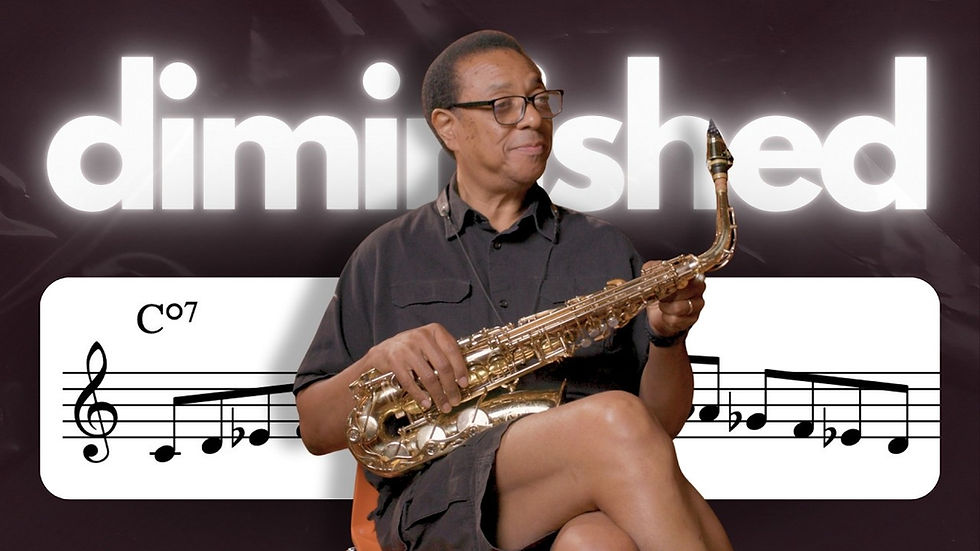How to Master Jazz Articulation & Inflections feat. Patrick Bartley
- Jazz Lesson Videos

- Sep 29
- 4 min read
Articulation and inflection are great ways to bring your playing to another level. With a few small tricks, you can give an extra layer of expression to your playing and helps you make a line your own.
And while everyone loves things like chords and harmony, articulation, dynamics, and inflection can be overlooked, despite how much of an impact they can have.
So today we’re going to talk about a few techniques you can use, but before we get going, if you want to dive even deeper on these concepts, make sure to check out Patrick’s course with Jazz Lesson Videos — Articulation and Inflection Techniques. In this course, you’ll get plenty of different techniques, along with some solo examples and opportunities to play along with Patrick. You can also follow along with all that we talk about today in our accompanying YouTube video, How to Master Jazz Articulation & Inflections feat. Patrick Bartley, where you can hear how Patrick plays through these examples.
Now let’s get playing!
Contents
Mute tonguing
One of the most common questions Patrick usually gets when talking about articulation is the mute tongue, sometimes called doodle tongue. There are other names for it as well, like bebop tongue, ghost tongue, etc. But basically, the point is, it's a halfway point between tonguing and not tonguing.
Mute tongue adds a more nuanced and softer approach. And sometimes it happens to outline the notes that otherwise would be just slurred. This helps give articulation to lines that otherwise wouldn't have it. So a way to think about mute tonguing is half-tonguing. When you do a mute tongue, basically what you're doing is stopping the reed just enough so that it continues to vibrate, but not enough to get a full tongue.
This technique is something to practice, because it's gonna feel unfamiliar and weird at first. You’ll want to put your tongue on the reed, then try to imagine you're about to tongue and stop the reed. Release just a little bit, to where the reed still vibrates. Imagine there's still some air going through it, but just the tiniest bit, so you can still feel vibration both on your tongue and on the reed.
Mute tonguing is a great way to set up the articulation for the next note, because it will make the next note stand out even more.
1-5-9 exercise
One articulation exercise that Patrick created to help with Cannonball Adderley transcriptions and fatigue is an exercise he calls the 1-5-9. This exercise will help you build endurance and keep you focused so that you can get through fast passages cleanly in a very exciting way. The 1-5-9 in 1-5-9 means the first, fifth, and the ninth scale degrees of any major scale. And so what you're going to do is you're going to first create a rhythm, bouncing like a metronome on the first, fifth, ninth, fifth and the first—back and forth two times.

Next, we’re going to play the scale in between those scale degrees and make sure that you can keep the 1-5-9 accented. The goal is to hit the mute tongue right before every chord tone. If you're able to do that, then your 1, 5, and 9 should sound the same when you're playing—with the scale and without the scale.

As you do this every day, you can also feel free to increase the tempo, until you get to a point where you find your limit.
Bending and scooping
Now we’ll get fancy and talk about some bending and scooping on the saxophone.
Let's look at G on the saxophone. Doesn't matter if it's alto or tenor, because it's all the same note, but we’re looking at the G with the register key.

Normally, if we want to play G with a bend, we’ll choose the chromatic note that’s a half step below. So in this case, we're going to bend the F sharp. The fun thing about bending is that it's like you can almost use your imagination to shape the bend—you're quite literally shaping the bend. So if you imagine very slowly lifting your finger up to the next note. That's just one simple bend that you can do on any note.

Now we’re going to look at mouth bending. With this type of bend, we’re going to keep our fingers in the same place, but we’re going to bend with our embouchure. This is going to take some practice, but you’ll want to start on the note and try lipping down by dropping our jaw. You want to keep the mouth on the mouthpiece of course, as well as your tension on the reed, but we’re gradually loosening our jaw. And you can think of it almost like a screw — where you can tighten and loosen to get the bend you’re looking for.



Well that’s all we have for today, but if you’re interested in learning more about these topics, make sure to check out Patrick’s course with Jazz Lesson Videos, Articulation and Inflection Techniques, and if you want to see how Patrick plays through any of the things we talked about today, make sure to check out our accompanying YouTube video, How to Master Jazz Articulation & Inflections feat. Patrick Bartley.
We’ll see you next time!



Comments